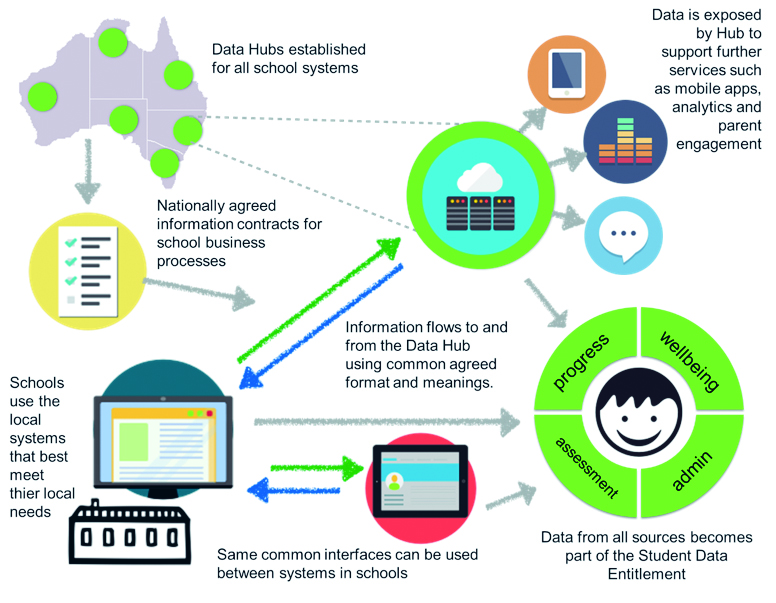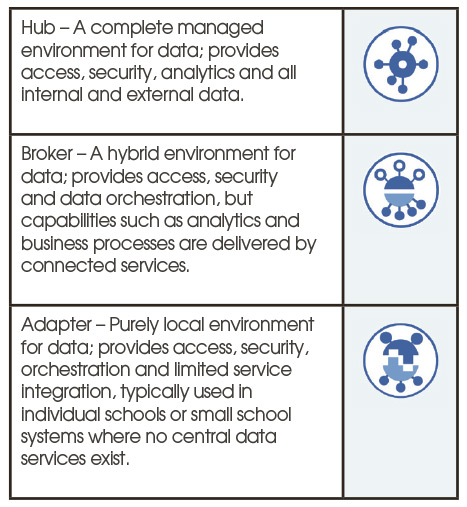| By Matt Farmer |
Digital technology has had a major impact on school education. Innovative gadgets and tools continue to surprise and challenge, but the greatest potential of technology in education is its power to capture, transform and communicate information – about things, about people and about the process of learning.
Schools can reasonably aspire to having ICT tools that provide a holistic view of learners and the learning process, enabling:
• a personalised learning experience for every student
• a consolidated view of learner needs and progress, and intelligent planning tools for teachers
• reliable and secure home-school communication
• reduced administrative burden for teachers and office staff.
Managing information in schools, however, is no simple business. By comparison with the stable workflows of commerce and industry, school education is a chaotic system. Teachers and school leaders need to make decision after decision based on information from many sources and in many forms to deliver and improve the learning experience for students.
Achieving a holistic view of education data means dealing with a growing number of potential sources, not to mention the trend from school-provided IT products to bring your own devices. Behind the scenes, the exchange of information between IT systems is often messy, error prone and labour intensive. Teachers can find themselves spending a lot of time entering and updating data to get their students learning online.
What is needed is a way of integrating and exchanging data from a growing array of IT products that is reliable and, from the user’s perspective, invisible – an approach that provides the capacity to extract meaningful insights from the countless data transactions that occur in schools every day.
The National Schools Interoperability Program (NSIP) was established by education ministers in 2010 to support the development of digital learning infrastructure nationally and improve access to information for all involved in school education. The NSIP has worked with education authorities and key education product suppliers to develop a Learning Services Architecture which provides a common national approach for schools, school authorities and service providers to exchange and integrate education information.
Learning Services Architecture
The Learning Services Architecture includes a data model, interoperability standards, business processes, data sharing agreements, technologies and infrastructure patterns that are common or aligned across the Australian school education sector. It provides software developers and IT decision makers with the blueprint they need to design or select products that can work together and exchange data faithfully, efficiently and safely.
Above all, it provides a consistent, learner-centric approach to managing and exchanging education data across the range of IT systems and organisations involved in school education.
Information for Learning and Teaching
Teachers are working hard to provide an individualised learning experience based on evidence of need, capability and progress. Learning resources are as likely to come from the cloud as from the school library and evidence of learning exists increasingly in a digital form. The available data includes measures of engagement and wellbeing as well as grades on tests and assignments.
The Learning Services Architecture enables the sharing of up-to-date information from the school administration system with all other systems – to manage the timetable, attendance, network access, welfare, communication and, of course, learning. It also provides for data from disparate sources to be combined, providing insights into learner needs and achievements.

Figure 1: Mobilising and making sense of education data
Information for Improvement
Improving educational outcomes depends on the availability of high-quality information to benchmark the current position and to set and monitor progress towards goals. The measures used range from academic performance to behaviour, to collaborative skills and wellbeing, and are likely to change over time.
The Learning Services Architecture provides a framework that allows for all of the data transacted in the learning and administration processes to be utilised as potential measures of progress and improvement. New data sources can be introduced and new perspectives provided. Analytical and support tools can be added, interchanged and upgraded.
Managing Relationships
Parent involvement in schooling and the reliance on IT-based systems to enable home–school communication is a developing trend. Whether it is updating emergency contact or health information, obtaining parental permission for a school activity, managing attendance, conducting financial transactions, reporting on progress, or communicating with teachers, there are few situations where accuracy and reliability of information, and information exchange, are more critical.
As part of the holistic view of student information encompassed by the Learning Services Architecture, relationships between each student and the significant individuals, groups and events in their journey through schooling are central. These relationships, which are typically managed through different IT systems in the school (student admin, timetabling, learning and assessment platforms), can be brought to bear to support learning and enable effective and safe communication across the school community.
Good News for Principals and Administrators
The Learning Services Architecture is also making it possible for schools to mix and match ICT products in a way that provides data integrity across multiple administration and learning tools and reduces risks associated with data exchange between organisations. If a new student enrols, or family details or class groups change, the updated information needs to appear wherever it will make a difference, with minimal delay, risk and human intervention.
Government school authorities and a number of Catholic school networks are in the process of implementing school administration systems based on the standards in the Learning Services Architecture. This means that schools have the benefit of local choice of ICT products, while still benefitting from economies of scale and data mobility within and between schools.
The Learning Services Architecture is also providing opportunities to streamline reporting of school data to school authorities.
Inside the Learning Services Architecture
The Learning Services Architecture is based on internationally recognised interoperability standards designed specifically for school education (www.nsip.edu.au/learning-services-architecture). It includes a data model that captures nationally agreed definitions of education data used in schools and the relationship between key data elements. This not only provides a consistent understanding of what the data means, but also helps to maximise the efficiency and fidelity of data exchange between IT systems. The data model, which also allows for local elaboration where required, is maintained by a coalition of school authorities and leading software providers (www.nsip.edu.au/list-sif-association-au-member).
The Learning Services Architecture is underpinned by a localised version of the Systems Interoperability Framework (SIF). SIF allows for secure, two-way web-based exchange of rich education data, and can be implemented on various levels of scale, from the direct integration between two applications at the school level to fully featured education data hubs such as those being implemented by school system authorities.

Figure 2: Models for integrating education data systems based on the Learning Services Architecture
The NSIP is working with the school authorities and product suppliers to ensure that other interoperability standards are incorporated into the Learning Services Architecture as required. The aim is to mobilise education data while maximising the quality, value and security.
National Interoperability Roadmap
The interoperability standards are applicable to all schools and are progressively being adopted nationwide by school authorities, product suppliers and government-provided IT platforms, such as the system being developed to deliver NAPLAN Online.
The NSIP is in the process of developing an interoperability roadmap, indicating the timeframes in which school sector authorities will offer or require integration of third party products using the standards defined in the Learning Services Architecture.
How to Get Involved
For schools that are part of a government or Catholic school system, the Learning Services Architecture is likely to be coming to them in conjunction with upgrades to school administration systems or changes to procurement policy for ICT products. If schools are considering purchasing a new ICT product or making better use of existing ones, they should contact their school authority or product supplier and ask about the national interoperability standards and the Learning Services Architecture.
Independent schools should make contact with the product suppliers or contact the NSIP team.
The NSIP team will be on hand at the EduTECH Expo in Sydney (8–9th June). It is a great opportunity for principals and school administrators to talk with the NSIP and suppliers currently supporting the Learning Services Architecture. The NSIP will also be running the annual Interoperability Challenge at EduTECH.
Further information about the NSIP, the Learning Services Architecture and the Interoperability Challenge is available at www.nsip.edu.au
This article was a collaboration between Matt Farmer, Program Lead – Products and Market Engagement, National Schools Interoperability Program (NSIP) and the NSIP Team.
SUBSCRIBE TO OUR NEWSLETTER [mc4wp_form id=”4523″]


Latest posts by Education Technology Solutions (see all)
- Keypath Education Launches AI-enabled Short Course Platform to Drive Career Progression for busy Professionals - February 19, 2025
- Lumify Work Partners with AI CERTs™ to Bring Cutting-Edge AI Certifications to ANZ & PH - February 5, 2025
- BenQ Launches First EDLA-Certified Interactive Displays for Education with Google Mobile Services (GMS) - November 17, 2023
You must be logged in to post a comment.


There are no comments
Add yours